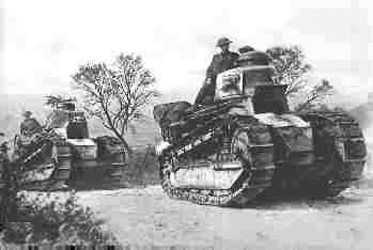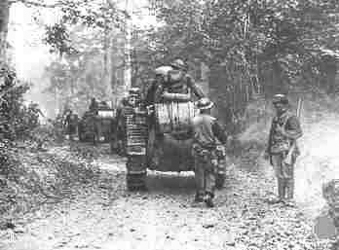US Tank Corps
L'US Tank Corps fut créé entre le 22 décembre 1917 et le 26 janvier 1918, au sein de l'American Expeditionary Force (AEF) alors sous les ordres du Général John J. Pershing. Cette unité participa aux derniers combats de la 1re guerre mondiale mais sera disoute en 1920. Notons que si son premier commandant en chef fut le Colonel Samuel Rockenbach, le premier officier incorporé dans ce nouveau Corps fut un certain Capitaine George S. Patton.
US Tank Corps was created between on December 22, 1917 and on January 26, 1918, into the American Expeditionary Force (AEF) then under the orders of the General John J. Pershing. This unit took part in the last combat of the 1st world war but will be dissolved in 1920. Let us note that if its first commander-in-chief were Colonel Samuel Rockenbach, the first officer incorporated in this new Corps was a certain Captain George S. Patton.

Le Tank Corps américain devait à son origine incorporer 2000 chars légers français Renault FT et 200 chars lourds britanniques Mark IV. Finalement, 20 bataillons de chars légers (77 chars chacun) et 10 bataillons de chars lourds furent planifiés. Cependant 21 bataillons de chars légers (326-346) et 8 bataillons de chars lourds (301-308) seront finalement créés. Parmi tout ces bataillons seul le 301e bataillon de char lourds, et les 331/344 et 345e bataillons de chars légers furent utilisés au combat en Europe de l'Ouest. Le 301e bataillon de char lourds fut formé à Camp Meade (Maryland) et entraîné à la Tank School de Bovington (Angleterre). Les 344e et 345e bataillons de chars légers (anciennement 326e et 327e) furent formés et entraînés à la Patton's school de Bourg (France).
The American Tank Corps owed at its origin to have 2000 light tanks French Renault FT and 200 British heavy tanks Mark IV. Finally, 20 battalions of light tanks (77 tanks each one) and 10 battalions of heavy tanks were planned. However 21 battalions of light tanks (326-346) and 8 battalions of heavy tanks (301-308) will be finally created. Among all these battalions only the 301st heavy battalion of tank, and the 331/344 and 345th battalions of light tanks were used in the combat in Western Europe. The 301st battalion of heavy tanks was formed at Camp Meade (Maryland) and was sent at the Tank School de Bovington (England) for its training. The 344th and 345th battalions of light tanks (in the past 326th and 327th) were formed and trained in Patton' S school at Bourg (France).
 |
 |
US Tank Corps
Renault FT's in action |
|
src: Doughboy
Center
|
|
Les chars Renault FT des 326e (344e) et 327e (345e) bataillons de chars légers, au sein de la 304e Tank Brigade, furent les premiers utilisés au combat lors de la bataille de Saint Mihiel, avec le IVe US Corps, le 12 septembre 1918, puis lors de l'offensive de Meuse-Argonne, avec le Ve US Corps, le 26 septembre. Les chars Renault FT du 331e bataillon de chars légers, au sein de la 306e Tank Brigade) participèrent également à l'offensive de Meuse-Argonne, au mois de novembre. Les chars Mark V du 301e bataillon de chars lourds (4e British Tank Brigade, Australian Corps), subirent de lourdes pertes lors de la bataille du canal de Saint Quentin, le 29 septembre 1918. Cependant, le 301e captura le village de Brancourt le 8 octobre et participa à la bataille de Selle le 18 du même mois. Toujours le même mois (23-23 octobre), il participa à une attaque nocturne dans les alentours du canal de la Sambre.
The tanks Renault FT of the 326th (344th) and 327th (345th) battalions of light tanks, within the 304th Tank Brigade, were the first used in the combat at the time of the battle of Saint Mihiel, with US IVth Corps, on September 12, 1918, then at the time of the offensive of Meuse-Argonne, with US Vth Corps, on September 26. The tanks Renault FT of the 331st battalion of light tanks, within the 306th Tank Brigade) also took part in the offensive of Meuse-Argonne, in November. The tanks Mark V of the 301st battalion of heavy tanks (4th British Tank Brigade, Australian Corps), underwent heavy losses at the time of the battle of the channel of Saint Quentin, on September 29, 1918. However, the 301st captured the village of Brancourt on October 8 and took part in the battle of Selle the 18 of the same month. Always the same month (22-23 October), it took part in a night attack in the neighbourhoods of the channel of Sambre.
301st
Heavy Tank battalion (late 1918) |
||
Bttn HQ |
||
1 Renault FT |
||
Company A |
Company B |
Company C |
9 MK V* male 2 MK V* female 4 MKV* hermaphrodite |
7 MK V* male 2 MK V* female 3 MKV male 1 MKV female 3 MkV hermaphrodite |
7 MKV* hermaphrodite 9 MKV hermaphrodite |
4th
Tk Supply Co |
||
8 Supply Tanks |
||
 |
Mark V Male |
src: Great
Britain Tanks
|
Après l'armistice du 11 septembre et dans le cadre de la ré-organisation de l'US Army, le Général Pershing, en 1919, recommanda que le Tank Corps soit dissout et ses différent élément versés dans l'infanterie. En 1920, le National Defense Act entérine ce souhait et les divers unités de chars furent réaffectées dans l'infanterie. Seuls 2 bataillons de chars lourds et 4 bataillons de chars légers avaient échappé à la démobilisation et furent donc effectivement réaffectés.
After armistice of September 11 and for the reorganization of US Army, the General Pershing, in 1919, recommended that the Tank Corps will be dissolved and its different element poured in infantry. In 1920, the National Defense Act ratifies this wish and various units of tanks were reallocated into infantry. Only 2 battalions of heavy tanks and 4 battalions of light tanks had escaped at the demobilization and thus were actually reallocated.